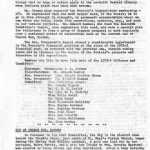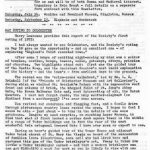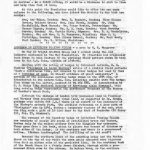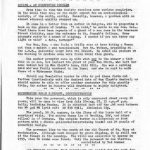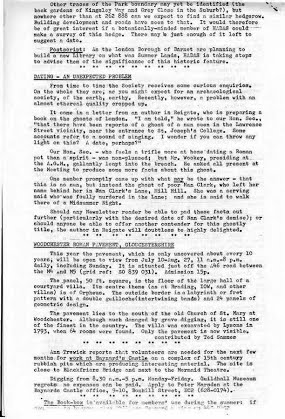
Page 1
The 12th Annual General Meeting
This took place on May 15 at St. Mary’s Church House under the Chairmanship of Vice-President Mr. Eric Wookey, with 56 members attending.
It seems likely that this will be our last meeting at Church House. Councillor Brian Jarman, presenting his Annual Report, mentioned that we hope to return again to the re-built Central Library when lectures start once more next Autumn.
Mr. Jarman also reported the Society’s highest-ever membership – 174. He emphasised that our most urgent need, if the Society is to go from strength to strength, is permanent accommodation where we can store or tools, finds from excavations, archives, etc., and work on our various projects. Mr. Edward Sammes, who read the Research Committee’s report, also emphasised this need. And made a special plea for volunteers to form a group of diggers prepared to work regularly over a sustained period on excavations such as the current one at Church End, Hendon.
The Hon. Treasurer’s report showed a considerable improvement in the Society’s financial position at the close of the 1972/3 financial year, as compared with the previous one, despite rising costs and an increase in the number of the Society’s projects and therefore expenditure.
Members may like to have a note of the 1973-4 Officers and Committee:
Chairman: – Councillor E. A. Jarman
Vice-Chairman: – Mr. Edward Sammes
Hon. Secretary: – Mrs. Brigid Grafton Green
Hon. Treasurer: – Mr. Richard Deacon
Committee: – Mrs. Christine Arnott
– Mr. Jeremy Clynes
– Mr. G. M. T. Corlet
– Mr. John de F. Enderby
– Miss Celia Gould
– Mr. Eric Grant
– Miss Elizabeth Holliday
– Mrs. Daphne Lorimer
– Mrs. Dorothy Newbury
– Mrs. Nell Penny
– Miss Ann Trewick
– Mrs. Freda Wilkinson
– Mr. Eric Wookey
Dig at Church End, Hendon
As forecast in the last Newsletter, the dig in the cleared area beside the Clerk’s House, just south of St. Mary’s Parish Church, began during the spring Bank Holiday Weekend. The grid was laid out by our survey, Barry Martin, and a site hut (found by Mrs. Dorothy Newbury) was erected by Percy Reboul and John Heathfield. After a busy Saturday during the many odd jobs which precede a dig (such as moving to walls to the hut and checking them, painting trench pegs and re-numbering them) five trenches were marked out within the grid. Digging began in earnest on Sunday May 27th.
It’s too early yet to report any interesting finds, but digging will go on every weekend (weather permitting) from now until 31 October:
on Saturday (except when there is a Society outing) from 2 p.m. to 6 p.m.
on Sundays from 10.00 to 6.00 (with a break for lunch).
Page 2
The Committee hopes that all members who possibly can and will help with the dig. If you have not volunteered yet, please do it now — either for active digging or, if you prefer quieter pursuits, for pot-washing, sorting, etc. Offers of help can be made to Mrs. Dorothy Newbury who hopes to organise a steady stream of diggers.
Dates your the Diary
The Society’s outings this summer will be:
Saturday June 16th. Tamworth and Lichfield, which breaks new ground for us and will be of both Roman and Medieval interest. Organiser is Eric Grant – full details on a separate form enclosed with this newsletter.
Saturday 14th July. Wealden and Downland Museum, Singleton, Sussex.
Saturday September 15th. Blenheim and Woodstock.
May outing to Colchester
Harry Lawrence provides this report of the Society’s first outing in 1973:
I had always wanted to see Colchester, and of the Society’s outing on 19 May gave me the opportunity — and an excellent one — of exploring “England’s first recorded town”.
After some seven hours of exciting sight seeing my mind was a welter of temples, castles, keeps, towers, walls, gateways, abbeys, priories and churches. Two highlights stand out: first was the guided tour of the Castle Keep, and the Assistant Curator’s most lucid explanation of its history — and the town’s — from the earliest days to the present.
The second was the “criss-cross walkabout”, led by Mr L. C. Drinkell (of the “Friends of Colchester Museum’s and Art Galleries”), during which we visited St. Botolph’s Priory with its impressive West front and columns of brick, the knapped flint of St. John’s Abbey Gate, the Roman Balkerne Gate and, most interesting of all, the Dutch Quarter. I must not forget Jumbo, the only weather-elephant (as distinct from a weathercock) I’ve ever come across.
Tea revived our endurance and flagging feet, and a 6 mile drive through picturesque country lanes rested the eyes. I began to feel I would be able — just about — to take in the details of one more gatehouse. Imagine my awed surprise, on reaching Layer Marney, to find that what at first looked like a rather drab square tower in the middle of a range of Tudor buildings was in fact the rear of the most wonderful twin octagonal towered Gate I have ever seen or expect to see.
During an hour’s guided tour of the Tower House and adjacent Tudor brick church of St. Mary the Virgin we heard of the succession of families (some illustrious, some not) who had lived here and nurtured this gem of the Tudor bricklayer’s art. Funny to think how little a Tudor bricklayer earned — and that a modern bricklayer can get £100-£140 a week for work no one is likely to view with awe in 450 years time.
Having “discovered” Colchester I now look forward to at least two further visits under my own steam and at leisure — one to explore the town, a second to see the exhibits in the Castle.
The Society’s thanks are due to Ann and Colin Evans for making the Colchester outing a great success. They were responsible for it from the first suggestion of the idea right through to the thank-you letters written after the event — and the whole operation was most efficiently planned and performed. This was the first outing that they organised for HADAS — and we hope they will do many others.
Page 3
New Members
By the way we’ve been told that a Society outing can be something of an ordeal for new members. Those who have been in HADAS for some time may have forgotten how unnerving it is to face a coach load of strange people who all seem to know each other and none of whom know you. Next time you notice someone looking lost – or lonely, or nervous – on a HADAS outing, it would be a kindness to chat to them and help them feel at home.
At this point the newsletter would like to offer its own warm welcome to the following, who have joined the Society in the last two months:
Mrs. Ann Baker, Hendon; Mrs. B. Bennett, Hendon; Miss Glenys Davies, Golders Green; Mrs. Jane Gooch, Hendon; Mr. John Heathfield, East Barnet; Mr. Peter Hewitt, Totteridge; Mr. George Ingram, Hendon; Mr. E. H. Jack, Hendon; Miss Dorothy Jeremy, Hendon; Mr. Martin Kirby, Edgware; Mrs. D. A. Mendelstam, Hendon; Mr. & Mrs. G. H. Musgrove, Finchley; Miss J. A. Partridge, Hendon; Miss Alison Reboul, Hendon; Mr. Paul West, West Hendon; Mr. K. Wilins, Whetstone.
Hedgerow in Lyttleton Playing Fields
– a note by G. H. Musgrove.
On May 10th, Brigid Grafton Green and I walked along the old hedgerow mentioned in the My Newsletter. My attention had originally been drawn to this feature by the striking field pattern shown in this area by the O.S. 6 inch edition of 1894-96.
Dealing with the dating of hedges by botanical methods, W. G. Hoskins (Fieldwork in Local History writes of a similar field pattern; “Such a continuous line, not crossed by other hedges but used by them as a terminus ad quem, is itself evidence of great antiquity.” A portion of the continuous curving hedge shown on the 1894 map, if transferred to the modern 6 inch map, coincides exactly with the hedge-line shown on the latter, centred at TQ 262 888. As demonstrated by S. J. Madge (The Medieval Records of Harringay alias Hornsey), this long curving hedge represented the north-west boundary of the Bishop of London’s Great Park.
Although the Bishops of London have possessed land in Finchley and Hornsey from pre-Conquest times (and, as suggested by Dr. Madge, perhaps even before 604 AD) there is no record of the enclosure of the Bishop’s private Park. The earliest reference to a deer park at “Haringeye” was in 1241, during a temporary vacancy in the see, when the King made a gift of 10 live deer to the Earl of Pembroke (26 Henry III, Nov 15, Windsor).
The remnant of the boundary hedge at Lyttleton Playing Fields now consists of nearly 100 yards of established trees and bushes, broken only by a modern pathway from the Kingsley Way entrance. These grow from a low bank, which in places has traces of ditches on both sides of the hedge. At the southern end there is a pronounced hollow. (Modern landscaping? The infilling of an old pond?)
Between the northern limit of the existing hedge and the Mutton Brook on the day of our visit the mown grass appeared more vigorous than that on either side of the projected line. On the southern bank of the Brook, there is a fairly dense thicket, through which a pronounced ditch runs to the stream. In Watery Wood, on the northern bank, a number of isolated mature trees appear to continue the curved line of the boundary.
The (1841) field names are significant. “Watery Wood speaks for itself. “Summer Lands” (that part of the Playing Fields which lay outside the Great Park) indicates wetness during most of the year. We also have a field called “The Park”. The muddy clay of the area may have determined the limit of the Bishop’s Park at this, its lowest point.
Page 4
Other traces of the Park boundary may yet be identified (the back gardens of Kingsley Way and Grey Close in the Suburb?), but nowhere other than at 262 888 can we expect to find a similar hedgerow. Building development and roads have seen to that. It would therefore be of great interest if a botanically-minded member of HADAS could make a survey of this hedge. There may be just about enough of it left to suggest a date.
POSTSCRIPT – As the London Borough of Barnet are planning to build a new library on what was Summer Lands, HADAS is taking steps to advise them of the significance of this historic feature.
Dating – an unexpected problem
From time to time, the Society receives some curi9uos enquiries. On the whole they are, as you might expect from an archaeological society, of the earth, earthy. Recently, however, a problem with an almost ethereal quality cropped up.
It came in a letter from an author in Reigate, who is preparing a book on the ghosts of London. “I am told,” he wrote to our Hon. Sec., “that there have been reports of a ghost of a nun seen in the Lawrence Street vicinity, near the entrance to St. Joseph’s College. Some accounts refer to a sound of singing. I wonder if you can throw any light on this? A date, perhaps?.”
Our Hon. Sec., – who feels a trifle more at home dating a Roman pot than a spirit – was non-plussed; but Mr. Wookey, presiding at the A.G.M., gallantly leapt into the breach. He asked all present at the meeting to produce some more facts about this ghost.
One member promptly came up with what may be the answer 0 that there is no nun, but instead the ghost of poor Nan Clark, who left her name behind in Nan Clark’s Lane, Mill Hill. She was a serving maid who was foully murdered in the Lane; and she is said to walk there on Midsummer Night.
Should any newsletter reader be able to pad these facts out further (particularly with the desired date of Nan Clark’s demise(; or should anyone be able to offer another contender for this ghostly title, the author in Reigate will doubtless be highly delighted.
Woodchester Roman Pavement, Gloucestershire
This year the pavement, which is only uncovered about every 10 years, will be open to view from July 10th – August 27th, 11 a.m. – 8 p.m. daily including Sunday. It is situated just off the A46 road between the M4 and M5 (grid ref: SO 839 031). Admission 15p.
The panel, 50 ft square, is the floor of a large hall of a courtyard villa. Its centre theme (as at Brading IOW, and other villas) is of Orpheus. The outside border is a labyrinth or fret pattern with a double guilloche (intertwining bands) and 24 panels of geometric design.
The pavement lies to the south of the Old Church of St. Mary at Woodchester. Although much damaged by grave digging, it is still one of the finest in the country. The villa was excavated by Lysons in 1793,when64 rooms were found. Only the pavement is now visible.
(Contributed by Ted Sammes)
Diggers Required
Ann Trewick reports that volunteers are needed for the next few months for work at Baynard’s Castle on the complex of 15th century rubbish pits which are producing interesting material. The site is close to Blackfriars Bridge and next to the Mermaid Theatre.
Digging from 8.30 a.m. – 5 p.m., Monday – Friday. Guildhall Museum regrets no expenses can be paid. Apply to Peter Marsden at the Baynard’s Castle office.
Book Box
The book box is available for members during the summer: if you want to borrow, give Phillipa Bernard a ring.

